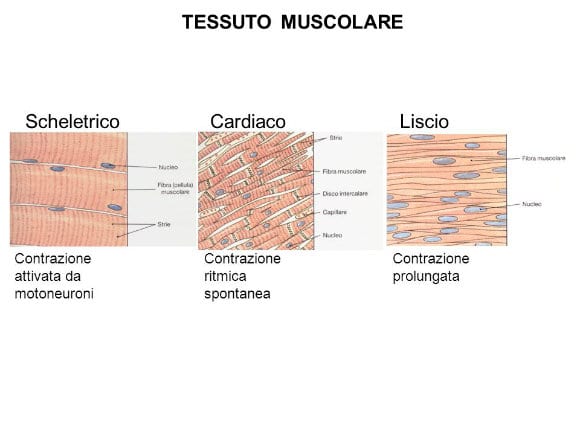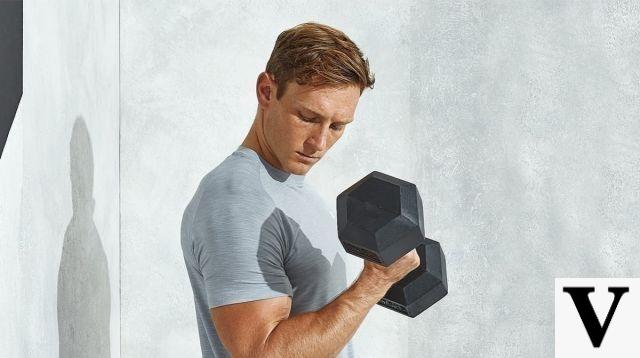By the healthiergang writer , student in Medicine and Surgery.
Muscle contraction
La muscle contraction it is the property of the muscle to shorten and perform its functions; what occurs is a electromechanical coupling where the nerve impulse is propagated to the muscle cell and converted into movement.
The most immediate example that can come to our mind is that of skeletal muscle, whose contraction allows us to lift a weight from the ground and is a type of voluntary contraction which, however, can also respond to reflex stimuli; let's not forget that certainly the most important muscle is the heart (whose cells contract about 86400 times a day!) which despite being a striated muscle it's involuntary.
The third type of muscle contraction is that of the smooth muscle, so called because it does not have the striations of the skeletal muscle, which we find in the digestive system and blood vessels and also here we speak of involuntary contraction (given by the autonomic nervous system).
So in summary there are 3 types of musculature which differ in some details during contraction.

Contraction in the Skeletal Muscle
The one of greatest interest for sportsmen is the contraction of striated muscle; the myocyte (i.e. the muscle cell) contains within it many proteins and enzymes that together form a single large machine: the morphofunctional unit is the sarcomero and is naturally composed of actin (globular protein that polymerizes into filaments) and myosin (composed of a filamentous part and two heads that interact with actin) which are the main actresses of contraction, tropomyosin (filamentous protein) and troponin (protein with globular subunits I, T and C); other proteins such as titin and nebulin are not directly involved in the mechanism, but constitute the anchor between the different sarcomeres.
To understand how everything happens it is useful to review the structure of the sarcomere: the thin filaments are those of actin and the thick filaments are those of myosin which form a sequence of dark bands (A) and light bands (I); within the I band we have a darker line, the Z line. The sarcomere is everything between one Z line and another.
In band A we have both actin and the heads of myosin molecules, in band I only actin. At the molecular level, having offered a general view of the sarcomeric proteins, a sliding of the myosin heads on the actin filaments takes place, the main purpose of which is to bring the two opposite Z lines closer together.
Initially the stimulus to contraction, propagated through the nerve fibers, reaches the synaptic button where it determines the release of the neurotransmitter (usually acetylcholine) and leads to the opening of the sodium channels and consequently, to the depolarization of those of calcium at the level of the Sarcoplasm.
The heads of the myosin are not attacked because the interaction is prevented by Troponin C; when Calcium binds to the latter, tropomyosin is brought with it and actin sites are discovered and so myosin can bind to them; at this point the myosinic ATPase splits the ATP from which it obtains the energy to push the actin towards the center of the sarcomere.
After this step, the myosin detaches from the actin and repeats the cycle for the entire time of contraction. The force that develops throughout the process is directly related to the number of acto-myosin bridges that are formed.
Two elements on which to say a few more words and without which the contraction could not take place are the Ca2 + ion and ATP. The Soccer enters the muscle cell thanks to the electro-mechanical coupling that guarantees the opening of the ion channels; the ion serves to displace tropomyosin (linked to troponin C) from the actin binding sites and allow the myosin heads to work; ATP is continuously constituted thanks to the oxidation of energy substrates, glucose and fatty acids, as well as promptly reconstituted in the first seconds of the exercise by creatine-phosphate; it is hydrolyzed by the myosin head and gives the energy necessary to perform the rotation.

In fact, it is common the feeling of effort and fatigue, until it is impossible to continue lifting, when lactic acid accumulates and the lowering of the pH prevents the formation of new ATP.
So the cellular mechanism is the one we have just seen but skeletal muscle can perform different types of contractions which are divided into two large families, dynamic and static, depending on whether or not the load is shifted:
1. Isotonic (dynamic) contraction: when the muscle is shortened by moving a load: it is so called because the tension is the same throughout the range of motion and what changes is the length of the fibers.
2. Isokinetic contraction (dynamic): produced when the muscle shortens at a constant speed under maximum tension; it is only possible with some machines defined as Isokinetic.
3. Auxotonic Contraction (dynamic): tension gradually increases during exercise (type with rubber bands).
4. Plyometric (dynamic) contraction: it is an explosive concentric contraction, preceded by an eccentric phase in which the necessary power is accumulated by exploiting the elastic elements of the muscle. Practically in the first part of the movement there is a muscle lengthening with development of tension (eccentric phase) which will be released in the second (concentric) phase where muscle shortening and the development of power take place (as in jumps).
5. Isometric Contraction (static): when the muscle contracts without shortening: this happens either because the resistance applied is equal to the muscle tension developed or because you want to leave the weight in a fixed position.
After talking about skeletal muscle in general, we can briefly focus on the differences in the contraction mechanism for the other two types, smooth and cardiac.
Smooth Muscle Contraction
In smooth muscle, contraction occurs after stimulation by the fibers of the Autonomous Nervous System or by some hormones (epinephrine); we do not find the sarcomere organization but the actin filaments are connected directly to the cell wall generating a less organized contraction and the ion channels used are those of Calcium rather than those of Sodium: the same Calcium that is used for contraction derives from the extracellular environment ( and not from the sarcoplasm).
Contraction in the Cardiac Muscle
In the heart muscle the stimulation does not take place through fibers of the nervous system, but there are particular cells, called pacemakers, which independently generate the impulse that is propagated to the muscle cells through nerve bundles.
Here, too, Calcium is the main ion of contraction: the quantity that enters the cell, after stimulation, serves to release Calcium from the plasma reticulum allowing electro-mechanical coupling as seen for skeletal muscle. We also see different types of contraction in the heart: Isometric, when the blood fills the ventricular chambers and there is an accumulation of tension without muscle shortening, and Isotonic, when the ventricular contraction pumps blood into the arteries.



























